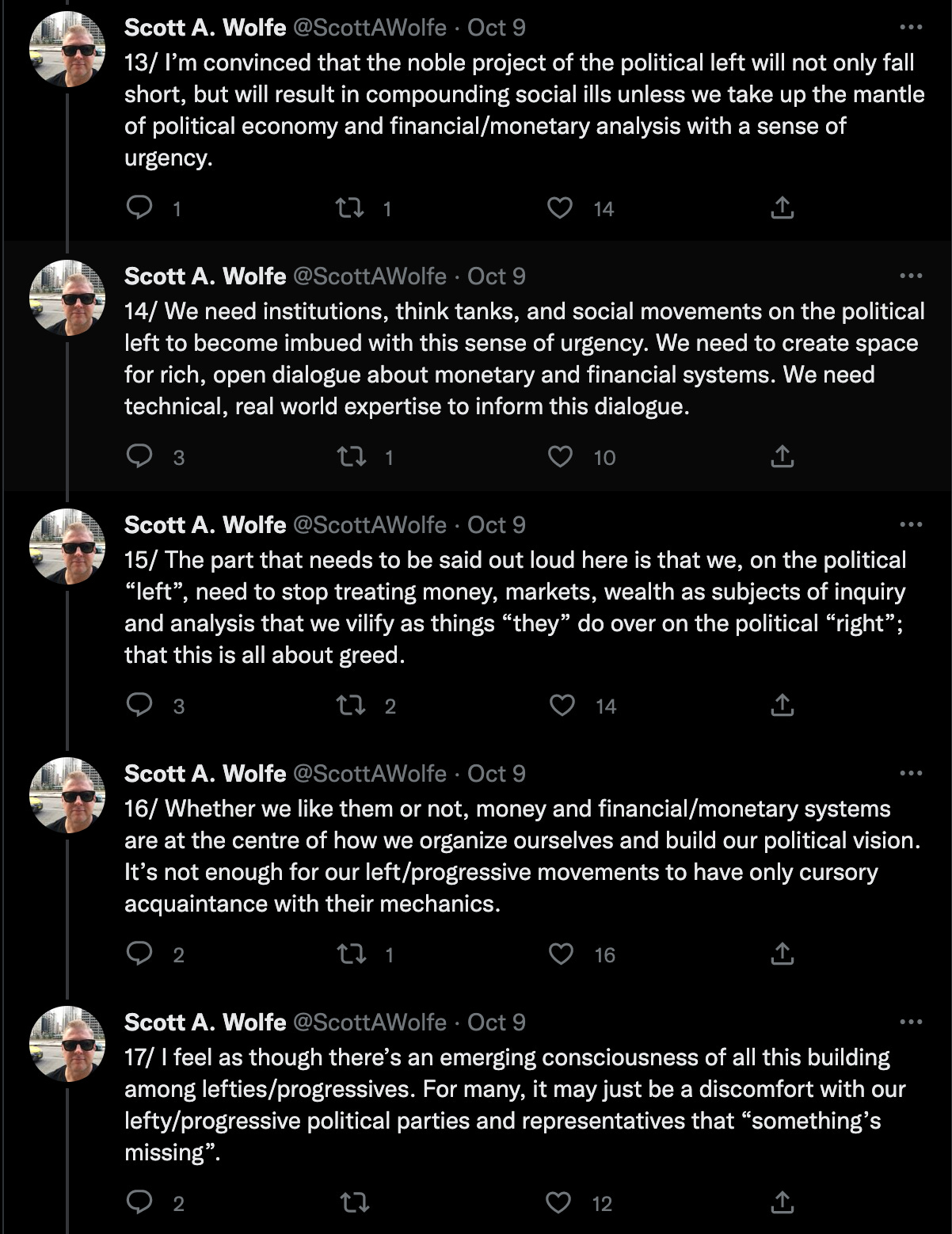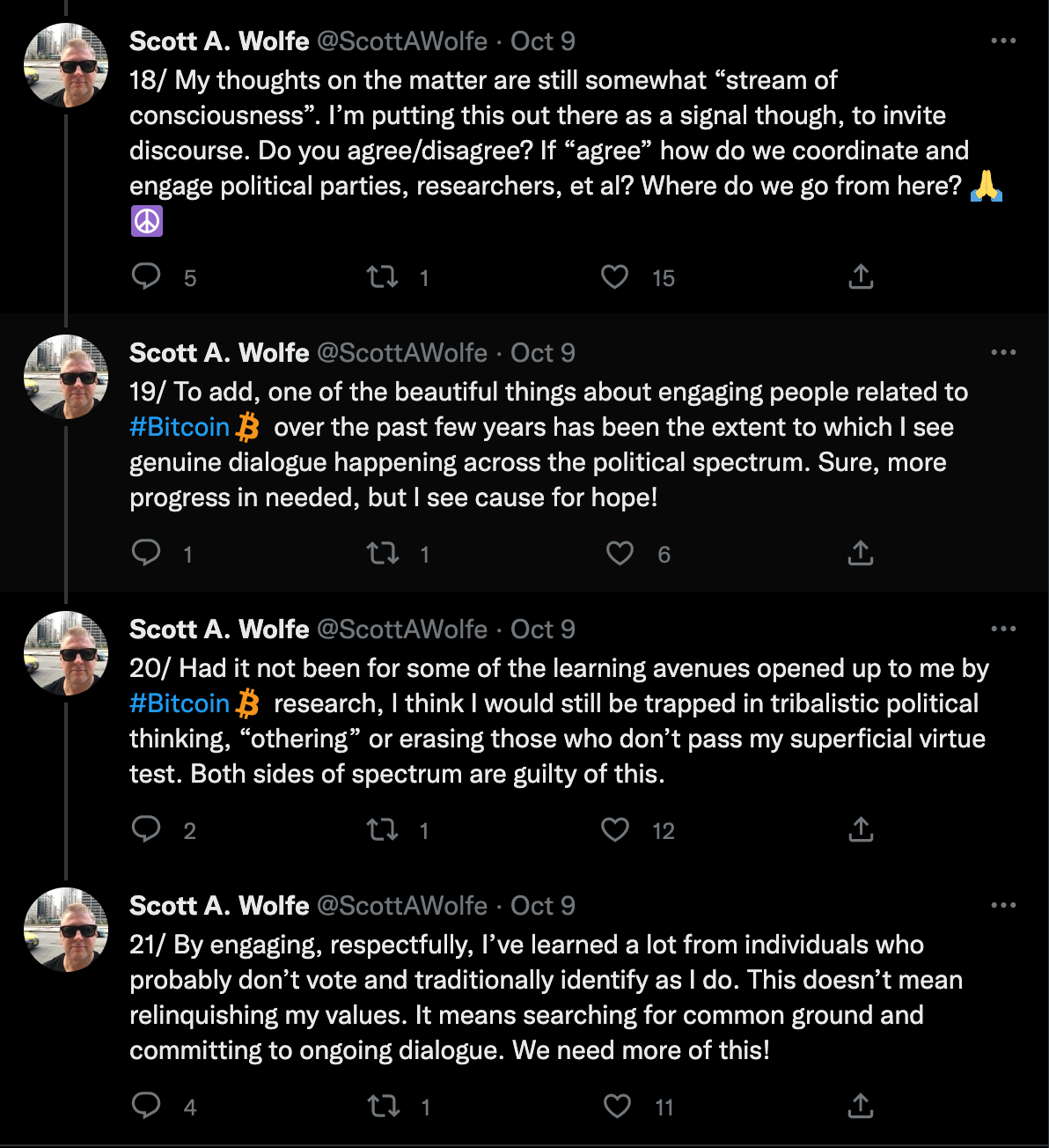How Bitcoin Creates a Better Environment for the Arts
Think Bitcoin Issue #43
Hey friends, welcome back to Think Bitcoin™ for issue #43. Special welcome to the new subscribers. I’m glad you’re here. As always, if you have any questions or comments, feel free to reach out. You can also find me on Twitter (@TheWhyOfFI) and connect with me on LinkedIn.
In this issue:
Long Reads: How Bitcoin Creates a Better Environment for the Arts
Content Round-Up: 2 videos
As always, if you find this newsletter interesting or useful, please share it with others who might find it interesting or useful, too!
This issue is sponsored by Orange Pill App. Connecting with other Bitcoiners is a great experience. Many of my own most interesting conversations each day occur with fellow Bitcoiners. Whether in real life or online, you can skip formalities and get right to discussing the transformative, wide-ranging effects of Bitcoin’s growth, knowing you share a hope for a more promising future. Thanks to Orange Pill App you will soon be able to meet Bitcoiners near you without the need to go to a meet-up or a conference. I can't wait to use this app myself!
Long Reads
How Bitcoin Creates a Better Environment for the Arts
Proponents of both Bitcoin and Web 3, respectively, acknowledge that the contemporary environment for serious art is dire. Web 3 advocates focus attention on the untenable (and yet entrenched) current system of remuneration in the arts. Think Spotify’s paltry pay-outs to musicians, which is frequently cited by folks working to advance things like music NFTs. The environment and payment architecture for creators working to make visual art, to write literary fiction, to make serious films, etc. is simply dreadful. We all know the trope of the starving artist and the English major turned barista.
The underlying problem is that it is hard for artists, particularly those engaged in serious work, to make a living. At this point I think it would be useful to define what I mean when I say “serious art.” By this term I mean art that is not meant primarily to divert, to pacify, or to narcotize; art that is not purely made for entertainment value; art that, though it may certainly be quite entertaining, is also meant to be instructive or redemptive on a deeper level. The financial rewards for artists working in this vein are minimal in our current cultural environment.
So we have this problem of artists not making much money, coupled with the dearth of serious art getting mainstream distribution and cultural penetration. We want to solve these problems because society is richer and more vibrant when we have a serious audience and serious art. Web 3 proponents and Bitcoiners tend to approach and conceptualize these problems in two distinct ways, the latter conceptualization being perhaps most notably captured by Saifedean Ammous in The Bitcoin Standard.
And both approaches are fundamentally flawed because they fail to fully reconcile or bring into balance the gift and the commodity components of art’s somewhat uncomfortable relationship with commerce. To elaborate on why both approaches are flawed, I want to talk about a writer named Lewis Hyde. He wrote a book called The Gift, which is probably your favorite writer’s favorite book. The Gift is about art and creativity in our thoroughly financialized modern world.
More specifically, the book differentiates between art and commodities, positing that art exists, albeit with friction, in two economies: the gift economy and the market economy, respectively. Hyde asserts that only one of these economies is essential to art, though.
“A work of art can survive without the market,’ he writes, but “where there is no gift, there is no art.”1
What is this “gift,” then that Hyde is talking about? It refers both to the way art is created and to the way it is received and processed by the audience. Art is “the emanation of its maker’s gift," meaning an emanation of both the maker's talent (which cannot be bought) and his inspiration/intuition (which also cannot be bought). Art that moves us is “received by us as a gift is received,” which is to say "when we are touched by a work of art something comes to us which has nothing to do with the price."2
Equipped with these ideas and definitions about art, we can examine precisely why the perspectives on art from both Web 3 and Saifedean Ammous are fundamentally flawed.
Let’s begin with Web 3. And I want to be clear here and say that I’m not referring to every single project in Web 3, nor am I foreclosing the possibility that Web 3 will eventually foster an environment for art that appropriately balances the gift and market economies, respectively, to which art belongs. I do not intend to speak on the space monolithically, but rather to address the embedded conceptions of art in theses like that of Cooper Turley, music-NFT advocate and founder of Coop Records. I am speaking to those who advocate for the total and complete commoditization of art and also, importantly, of artist.
This approach to art empties it of its gift qualities.
By commoditizing and creating secondary markets out of every piece of the artistic process, and by turning the audience into audience-cum-investor/speculator, the incentive structure for both creation and reception of art is indelibly changed.
After all, if you are a musician who has become a corporation owned by fans-cum-investors, who trade your commodified art on myriad secondary markets, perhaps even through increasingly exotic derivatives, are you incentivized to patiently cultivate and court your gifts or to produce that which will create the biggest monetary return on investment? Does such a culture produce a D’Angelo, someone who notoriously takes half a decade or more to birth a record? Does it create an environment where artists can take risks? Where they can create work that might be considered difficult (but rewarding)? Work that seeks to do more than merely divert or entertain?
I understand why financializing every aspect of artistic creation seems superficially alluring and even empowering. The status quo Spotify model for artist remuneration is awful, and any improvement on the power dynamics of that incumbent system is welcome. I don’t quibble with the motive. My issue is with the effect this kind of hyperfinancialization will have on art and its audience.
I’ve written and talked a lot about the idea of hyperfinancialization and about how Bitcoin is a powerful force for definancialization. So, surely a Bitcoiner like Saifedean Ammous has the answer to all this, right?
With all due respect to Ammous, not quite. While some of the prominent Web 3 folks err by seeking (unintentionally, I think) to remove all aspects of the gift economy from an artist’s process of creation and production, Ammous errs by, among other things, completely ignoring the gift component of an audience’s reception of art.
In The Bitcoin Standard, Ammous spends about five pages talking about art. Pretty safe to say it’s not the best five pages in the book. Ammous focuses on the monetary environment in which artists worked and essentially says that a low time preference environment creates great artists, while a high time preference environment cannot create great artists. He makes the (I would argue) non-credible claim that basically all art made after the mid-19th century is “garbage” made by “talentless hacks.”
I don’t think the insight that a low time preference environment is more conducive to the flourishing of great artists is wrong. But I think the argument that great art doesn’t exist in the fiat era is profoundly wrong. The issue is with the audience. There is plenty of great, serious art being made (and much has been made since 1850). The audience for such art, however, is ever-diminishing.
The audience for this work is shrinking in no small part because of the high time preference monetary environment created by the fiat system.
To bring this back to Lewis Hyde, I think the fiat system gradually degrades the audience’s capacity to receive art as a gift. We are working longer hours for less purchasing power while things like houses, higher education, and healthcare grow comically unaffordable for most.
Our money loses value so, rather than save, we are incentivized to spend, invest, or speculate. We are also the most advertised-to humans to ever walk the earth. Not exactly the ideal environment for tackling a long novel, listening to a record front-to-back, memorizing a poem, staring at a painting, or watching a serious film.
These works of art are nevertheless still being made, however. Ammous argues everything in the last century is garbage. Has he not read Proust? Has he not seen a Wong Kar-wai film? Looked at Guernica? Has he never gotten lost in a Toni Morrison sentence? Arvo Part, Krzysztof Kieślowski, T.S. Eliot? Coltrane (John and Alice)? Is the whole genre of jazz garbage? Of course not. Ammous just seems to have a particular hatred for Mark Rothko, which is of course fine. But it doesn’t mean Rothko is a “talentless hack” or that all art after 1900 is “garbage.”
Ammous describes art of the “golden era” as “speaking to man’s soul” and awakening him “to think of higher callings than the mundane grind of daily life” as if there isn’t art being made today (and throughout the 20th century) attempting to do precisely that. There is still art being made that is an expression of the creator’s gifts, presented in part as a gift to the world. But the audience has had its capacity to receive it as a gift utterly shriveled.
Bitcoin does create a better environment for the arts. Ammous is correct about that. But it’s not because increased bitcoinization means we’ll all start listening to classical music, denounce new media like the cinema, and return to realism of various flavors. Bitcoin creates a better environment for the arts because it helps facilitate a return of the gift exchange ethos, to creators and, more importantly, to the audience, which is necessary for art to live.
Bitcoin, by instilling a low time preference culture, restores the audience’s capacity for receiving art as a gift, a capacity which fiat’s high time preference culture has broken.
Bitcoin brings the gift economy and the market economy back into balance.
Content Round-Up
1. “From Bernie to Bitcoin,” an episode of The Bitcoin Source featuring yours truly. I really enjoyed this conversation with Dawdu Amantanah, who kindly invited me on to talk about my journey from Bernie to Bitcoin, how Bitcoin and politics interact, writing, and orange-pilling our communities. I encourage you to check out other episodes of the show, as well.
2. “Can Bitcoin Be Good For The Environment?” This is a fantastic conversation, facilitated by Dennis Porter, with Troy Cross, Daniel Batten, Adam Wright, and Nathaniel Harmon about a topic on which more Bitcoiners need to be literate.
3. This insightful thread from Scott Wolfe:
As always, thanks for reading! If you enjoyed it or found it useful, share this newsletter widely and freely!
“Civilization is in a race between education and catastrophe. Let us learn the truth and spread it as far and wide as our circumstances allow. For the truth is the greatest weapon we have.” -H.G. Wells
See you in two weeks,
Logan
SPONSORSHIP INQUIRIES: If you’re a Bitcoin company (or you work for a Bitcoin company) and you’re interested in supporting the newsletter, please reach out via Twitter DMs (@TheWhyOfFI) or email (askthewhyoffi@gmail.com).
SUPPORT
Send bitcoin to my Strike
SOCIAL
DISCLAIMER: I am not investment advisor and this is not investment advice. This is not, nor is it intended to be, a recommendation to buy or sell any security or digital asset. Nothing in this newsletter should be interpreted as a solicitation, a recommendation, or advice to buy or sell any security or digital asset. Nothing in this newsletter should be considered legal advice of any kind. This newsletter exists for educational and informational purposes only. Do your own research before making any investment decisions.
© Copyright Logan Bolinger, Think Bitcoin LLC
Hyde, Lewis. The Gift. Vintage Books. Originally published in 1979.
Id.











